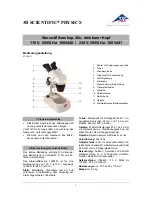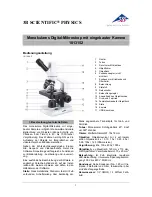
CENTER SCREEN AREA / IMAGE CONTAINERS - …
LSM 710 and LSM 780
Carl Zeiss
Raster Scanning Image Correlation Spectroscopy
Systems
246 M60-1-0025
e
02/2010
6.18
Raster Scanning Image Correlation Spectroscopy (RICS)
RICS is an image analysis tool that allows retrieving dynamic information from intensity images or image
stacks.
RICS analyses the two dimensional spatial correlation in x and y by shifting the image by spatial lag
increments and calculating the self similarity of the image.
In this way the correlation mage is of the same dimensions as the original intensity image, but it allows
the retrieval of diffusion coefficients and numbers of molecules by comparing the correlation function to
model diffusion functions.
In order that RICS algorithms work, the pixel size should be at least 5 fold smaller than the 1/e
2
beam
waist of the excitation light.
For example, the beam waist of a C-Apochromat 40x W NA 1.2 objective is 300 nm, so the pixel size
should be at least as small as 60 nm. Best results are obtained, if pixel sizes are 10 fold smaller than the
beam waist.
Another pre-requisite is the correct scanning speed. This should match the diffusion coefficient of your
molecule. As rule of thumbs for molecules diffusing with D > 100 µm
2
/s a speed of 4 µs/pixel is adequate.
For molecules diffusing with a D = 10 - 100 µm
2
/s a speed approximating 8-32 µs/pixel dwell time will be
appropriate.
Especially too high and slow speeds should be avoided. All molecules with extreme low diffusion
coefficients (D = 0.1 -10 µm
2
/s) should be sampled at 32-100 µs/pixel dwelling time.
Deviations from these settings will result in intensity images not appropriate for RICS analysis.
Last not least molecular concentrations should stay between 1 nm to 1 µm. RICS works best with time
series of 20-100 images. More than one image is needed to first improve on the statistics, and second to
have the possibility to remove immobile and slowly moving structures.
The RICS procedure can therefore be divided by acquisition of a time series, removing slow moving and
immobile structures, computing the correlation and then fitting the data to model functions.














































